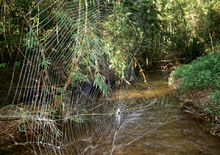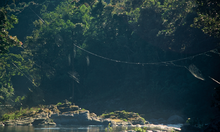- Darwin's bark spider
-
Darwin's bark spider 
A web of Darwin's bark spider Scientific classification Kingdom: Animalia Phylum: Arthropoda Class: Arachnida Order: Araneae Family: Araneidae Genus: Caerostris Species: C. darwini Binomial name Caerostris darwini
Kuntner & Agnarsson, 2010Darwin's bark spider (Caerostris darwini) is an orb-weaver spider that produces one of the largest known orb webs, web size ranged from 900–28,000 cm2 [1], with anchor lines spanning up to 25 metres (82 ft). The spider was discovered in Madagascar in the Andasibe-Mantadia National Park in 2009.[2] The species was named in honour of the naturalist Charles Darwin, with the description being prepared precisely 150 years after the publication of The Origin of Species, on 24 November 2009.[1]
Its silk is the toughest biological material ever studied, over ten times tougher than a similarly-sized piece of Kevlar. The average toughness of the fibres is 350 MJ/m3, and some are up to 520 MJ/m3, making the silk twice as tough as any other spider silk known.[3]
The web of Darwin's bark spider is remarkable in that it is not only the longest spanning web ever observed, but is among the largest orb webs ever seen, at an area of up to 2.8 square metres (30 sq ft).[1] Nephila komaci, discovered in 2009, and some other Nephila species also make webs that can exceed 1 m (3 ft 3 in) across.[2]
According to professor Ingi Agnarsson, director of the Museum of Zoology at the University of Puerto Rico, the spider's web occupies a unique biological niche: "They build their web with the orb suspended directly above a river or the water body of a lake, a habitat that no other spider can use".[2] This position allows the spiders to catch prey flying over the water, with webs observed containing up to 32 mayflies at a time.[1] The strong silk and large web are thought to have coevolved at the same time, as the spider adapted to the habitat.[3] Scientists are currently researching how the spider is able to weave such a large web over water along with being able to anchor drag lines on either side of a river.[2]
Like other spiders of the genus, Darwin's bark spider displays extreme sexual dimorphism, with large females (18 mm) and small males (6 mm).[1]
The spider was described along with a previously undescribed species of fly, which appeared to have a kleptoparasitic relationship with it. The flies often feed on the spider's catches before the spider wraps them. Occasionally, spiders have been observed to chase away the flies when they land on something that the spider is eating.[1]
References
- ^ a b c d e f Matjaž Kuntner & Ingi Agnarsson (2010). "Web gigantism in Darwin's bark spider, a new species from Madagascar (Araneidae: Caerostris)" (PDF). The Journal of Arachnology (American Arachnological Society) 38: 346–356. http://www.nephilidae.com/mk/articles/Kuntner&Agnarsson2010.pdf.
- ^ a b c d Matt Walker (16 September 2010). "Gigantic spider's web discovered in Madagascar". BBC News. http://news.bbc.co.uk/earth/hi/earth_news/newsid_9001000/9001866.stm. Retrieved 17 September 2010.
- ^ a b Ingi Agnarsson, Matjaž Kuntner & Todd A. Blackledge (2010). "Bioprospecting finds the toughest biological material: extraordinary silk from a giant riverine orb spider". PLoS ONE 5 (9): e11234. Bibcode 2010PLoSO...511234A. doi:10.1371/journal.pone.0011234. PMC 2939878. PMID 20856804. http://www.plosone.org/article/info%3Adoi%2F10.1371%2Fjournal.pone.0011234.
External links
 Data related to Caerostris darwini at Wikispecies
Data related to Caerostris darwini at Wikispecies
Categories:- Araneidae
- Spiders of Africa
- Endemic fauna of Madagascar
- Animals described in 2010
Wikimedia Foundation. 2010.



